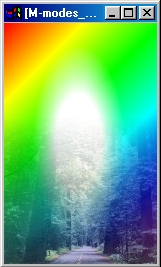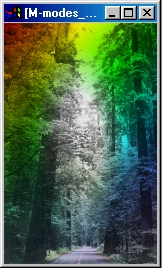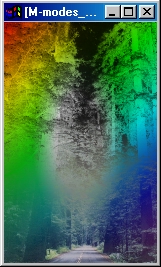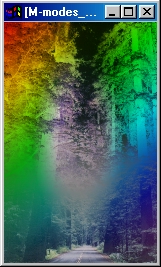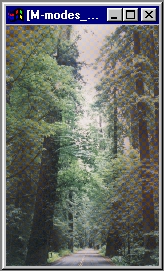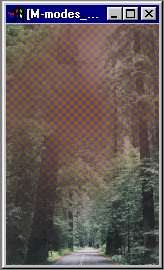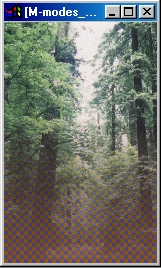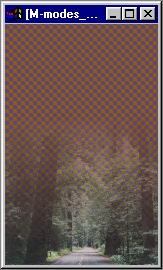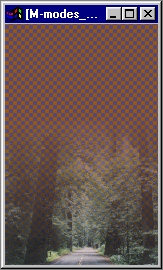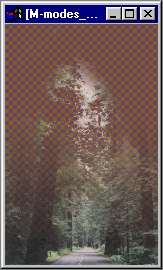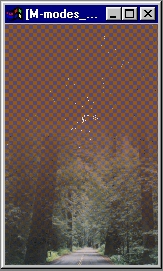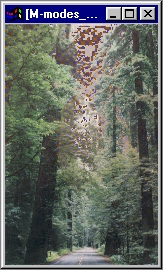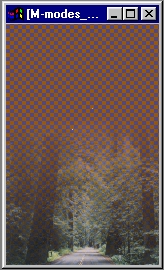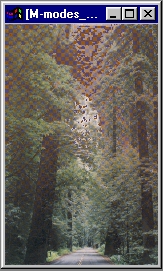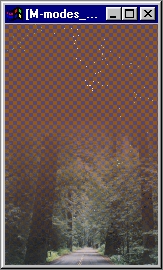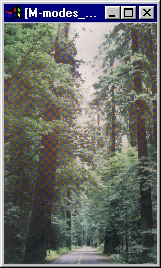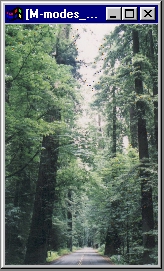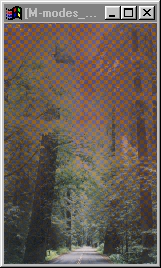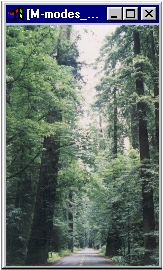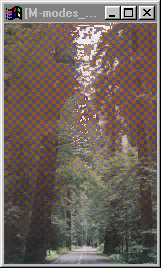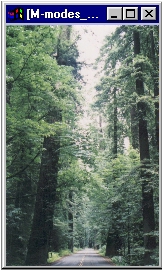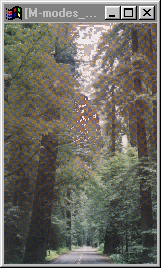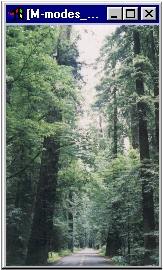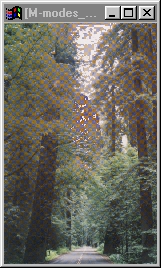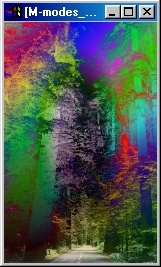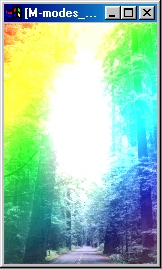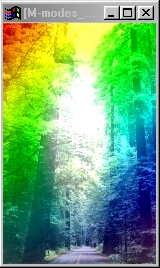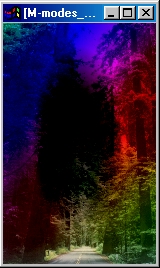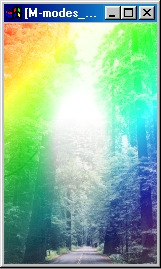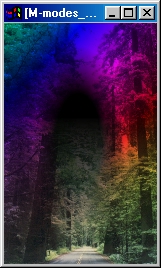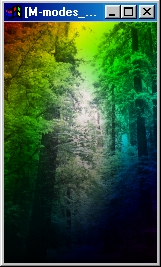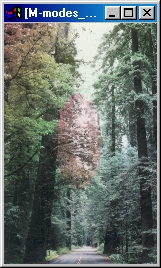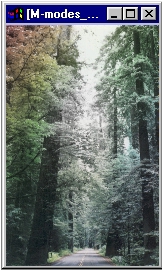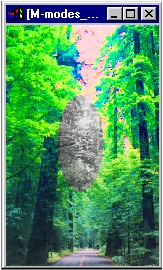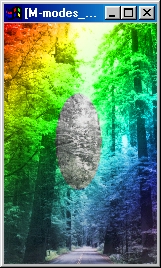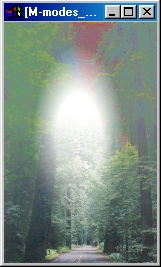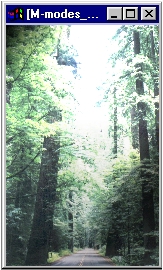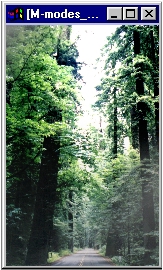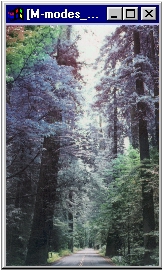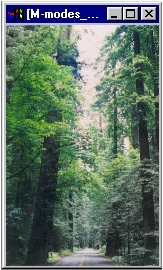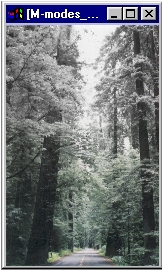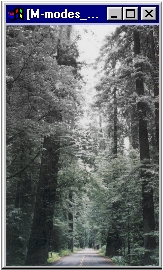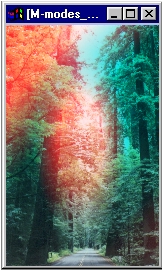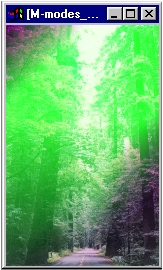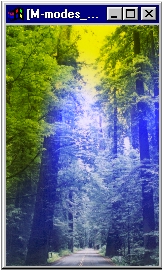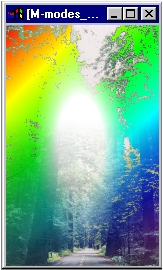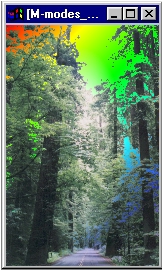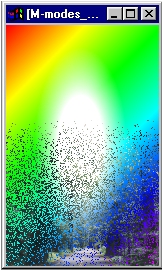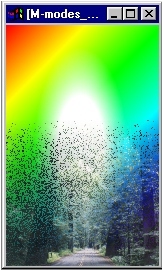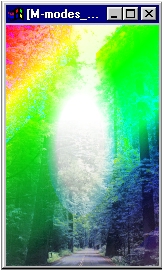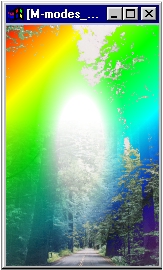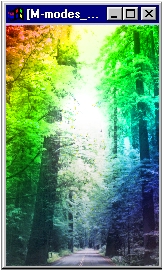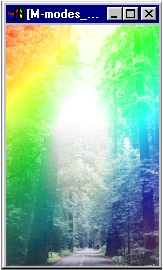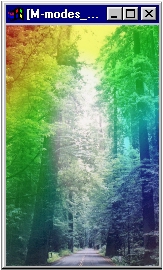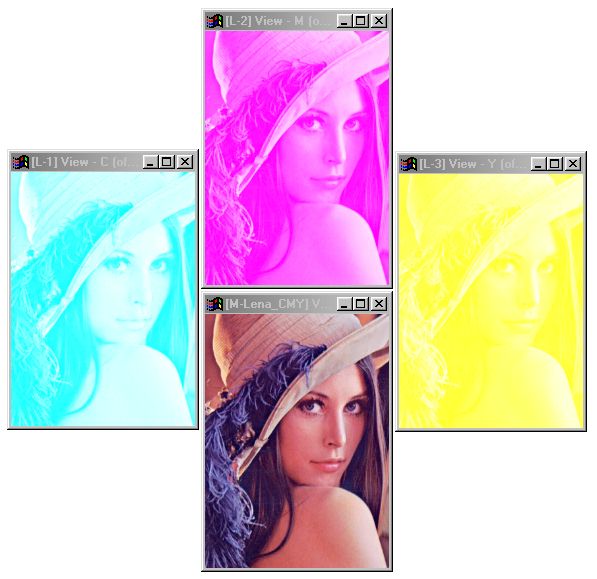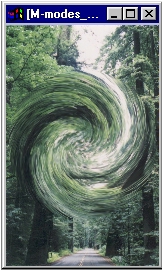| This is a child page. You can use Parent in the quick nav bar at the top or the bottom of the page to navigate directly back to the parent of this page. Some child pages are more than one level deep, and in that case will require more than one Parent click to reach the outermost document level. |
§ 13.15 - Layer Modes
§ 13.15.1 - General Layer Modes
Normal
In Normal mode, images are composed above lower layers according to the color in the image, and the alpha channel information in the layer.-
Behind
Behind is like normal layer mode in that it will apply the colors in a matte manner, except it will only produce results where the layer composite below is transparent, or partially transparent. The effect is to "protect" all pixel data already present in the layer composite before applying the pixel data in the behind mode layer. -
Monochrome
Where the layer is white, the layers below are converted to the monochrome average of their original colors. This operation obeys transparency. Colors other than white have interesting effects. -
Monochrome Negative
Where the layer is white, the layers below are converted to the B & W negative of their original colors. This operation obeys transparency. Colors other than white have interesting effects. -
RGB (Color) Negative
Where the layer is white, the layers below are converted to the color negative of their original colors. This operation obeys transparency. Colors other than white have interesting effects. -
Grey Mask Mode
Where the layer is white, opacity is applied. Where the layer is black, transparency is applied. Grey levels smoothly change from opaque to transparent. If the image is not greyscale, but color, then the luma level of the color is used (Red X .3, Green X .59, Blue X .11) -
Inverted Grey Mask Mode
Where the layer is black, opacity is applied. Where the layer is white, transparency is applied. Grey levels smoothly change from opaque to transparent. If the image is not greyscale, but color, then the luma level of the color is used (Red X .3, Green X .59, Blue X .11) -
Mask Mode
Where the layer is opaque, opacity is applied. Where the layer is transparent, transparency is applied. Intermediate transparencies and opacities are applied directly. RGB information in the layer is ignored. -
Inverted Mask Mode
Where the layer is transparent, opacity is applied. Where the layer is opaque, transparency is applied. Intermediate transparency or opacity is inverted, then applied. RGB information in the layer is ignored. -
RGB key (hard)
In hard RGB key mode, full opacity is applied if the color in the layers below precisely matches the color in the keying layer. If there is any difference, the layer will key out to fully transparent. -
RGB key (soft)
In soft RGB key mode, full opacity is applied if the color in the layers below precisely matches the color in the keying layer. The more different the color is from the key color, the more transparency is applied. -
Hue key (hard)
In hard Hue key mode, full opacity is applied if the color in the layers below precisely matches the hue (of the HSV color space) in the keying layer. If there is any difference, the layer will key out to fully transparent. -
Hue key (soft)
In soft hue key mode, full opacity is applied if the hue in the layers below precisely matches the hue (of the HSV color space) in the keying layer. The more different the hue is from the key hue, the more transparency is applied. -
Hue and Saturation key (hard)
In hard Hue and Saturation key mode, full opacity is applied if the hue and saturation in the layers below precisely matches the hue and satruation (of the HSV color space) in the keying layer. If there is any difference, the layer will key out to fully transparent. -
Hue and Saturation key (soft)
In soft hue and saturation key mode, full opacity is applied if the hue and saturation in the layers below precisely matches the hue and saturation (of the HSV color space) in the keying layer. The more different the hue and saturation is from the key hue and saturation, the more transparency is applied. -
Luma key (hard)
In hard Luma key mode, full opacity is applied if the luma in the layers below precisely matches the luma (of the HSV color space) in the keying layer. If there is any difference, the layer will key out to fully transparent. -
Luma key (soft)
In soft luma key mode, full opacity is applied if the luma in the layers below precisely matches the luma (of the HSV color space) in the keying layer. The more different the luma is from the key luma, the more transparency is applied. -
Inverted Luma key (hard)
In Inverted hard Luma key mode, full transparency is applied if the luma in the layers below precisely matches the luma (of the HSV color space) in the keying layer. If there is any difference, the layer will key out to fully opaque. -
Inverted Luma key (soft)
In Inverted soft luma key mode, full transparency is applied if the luma in the layers below precisely matches the luma (of the HSV color space) in the keying layer. The more different the luma is from the key luma, the more opacity is applied. -
Inverted Hue key (hard)
In Inverted hard Hue key mode, full transparency is applied if the color in the layers below precisely matches the hue (of the HSV color space) in the keying layer. If there is any difference, the layer will key out to fully opaque. -
Inverted Hue key (soft)
In Inverted soft hue key mode, full transparency is applied if the hue in the layers below precisely matches the hue (of the HSV color space) in the keying layer. The more different the hue is from the key hue, the more opacity is applied. -
Inverted Hue and Saturation key (hard)
In Inverted hard Hue and Saturation key mode, full transparency is applied if the hue and saturation in the layers below precisely matches the hue and satruation (of the HSV color space) in the keying layer. If there is any difference, the layer will key out to fully opaque. -
Inverted Hue and Saturation key (soft)
In Inverted soft hue and saturation key mode, full transparency is applied if the hue and saturation in the layers below precisely matches the hue and saturation (of the HSV color space) in the keying layer. The more different the hue and saturation is from the key hue and saturation, the more opacity is applied. -
Inverted RGB key (hard)
In Inverted hard RGB key mode, full transparency is applied if the color in the layers below precisely matches the color in the keying layer. If there is any difference, the layer will key out to fully opaque. -
Inverted RGB key (soft)
In Inverted soft RGB key mode, full transparency is applied if the color in the layers below precisely matches the color in the keying layer. The more different the color is from the key color, the more opacity is applied. -
Absolute Difference
This is the same as Difference, except that if the result is less than zero, then the results begin to increase again. This produces a very unusual result, and because the layer mode does extend beyond 0, we can fairly describe it as non-distorting. However, the results are so striking when this happens that you may have cause to think otherwise! -
Add
In add mode, images are added to the lower layers according to the color in the image, and the alpha channel information in the layer. When a channel reaches 255, it stays there. This can result in some color distortions at high amplitudes where the sum would have been higher than 255 in one or more of the RGB color channels. -
Add on Gray
In Add on Gray mode, images are added to the lower layers according to the color in the layer as it differs from gray (127), and the alpha channel information in the layer. Where the layer is brighter than 127, in increases the brightness of the layers underlying it; where it is darker than 127, it reduces the brightness of the layers underlying it. Where it is 127, it causes no change.This mode can produce glass-like effects quite easily. Like the normal Add mode, this limits excursions to 255, and to zero for values that are below 127 in the control layer.
See Also: Glass Text Tutorial using Layers
-
Difference
In difference mode, the contents of the layer are subtracted from the lower layers. When the result of the subtraction is less than zero, the layer is set to zero at that point. This can produce color distortions in some cases. -
Brighten
This will use the whiteness of the layer to brighten the layers below it. This is a nondistorting mode. -
Darken
This will use the brightness of the layer to darken layers below it. This is a nondistorting mode. Tip:
Tip: You can use the Darken layer mode to create a very effective comic book look. Here's the procees:
- Take the image you want to work with, and promote it to a layered image (Keystroke L)

- In the layers dialog, Duplicate this layer.
- Rename the top layer to "blur"
- Rename the bottom layer to "original" (they're the same at this point, so...)
- Set the layer mode on the "blur" image to Darken
-
Perform a Gaussian Blur on the "blur" layer. Try 200 as a setting. You should see an initial comic-like result in the master image immediately.
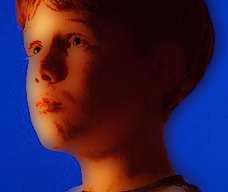
Now, if you like, you can enhance the lines on the image:
- Duplicate the "original" layer, and rename the duplicate to "edges"
- Using Sharpen, enhance the new layer. Try 50 as a radius and 50 as the amount setting.
-
Move the "edges" layer at the top, and set its mode to Darken. How's that?
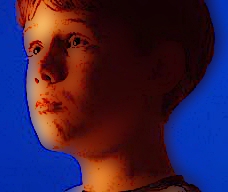
- Take the image you want to work with, and promote it to a layered image (Keystroke L)
-
Multiply
In multiply mode, the layer is multiplied against the lower layers and the result is composed onto those layers. This is the mode typically used for shadows. White pixels will result in no change to the lower layers, a black pixel will change a lower layer to black, and a gray pixel will darken the color of the layers below. Colors in a multiply layer will have unusual and interesting effects. A yellow region will result in a yellow region on all layers below the multiply layer; multiply can never brighten an image, as full white results in the same output as the layer below. So anything other than white darkens the result, even when the multiply layer contains a full brightness version of one of the six primary RGB colors (red, green, blue, cyan, magenta, yellow), unless that color is directly over the same color in the layers below. Tip:
Tip: Multiplying a layer by a copy of itself will darken already dark regions. You can do this to any layer by placing a copy of itself over it, marking that copy as local, and setting the copy (the higher layer) to multiply mode. We'll consider three cases that should explain the results completely:
Case 1: Consider the range of 0-255 in a pixel to represent 0.0 to 1.0. If the layer and the sublayer are both 255, the multiply is (1.0 x 1.0) and the result is 1.0 - no change.
Case 2: If the layer and the sublayer are both 128 (which would be the same as .5), then the multiply is (.5 x .5), which equals .25; the layer is now 25% instead of 50% bright. That's 1/2 the original brightness.
Case 3: If the layer and the sublayer are both 64 (which would be the same as .25), then the multiply is (.25 x .25), which equals .0625; the layer is now 6.5% instead of 25% bright. That's 1/4 the original brightness.
As you can see by these three example cases, the darker the layer is, the more it will darken when it is multiplied by itself.
-
Divide
The opposite of mulitply. The layer is treated as a fraction from zero to one, as it goes from 0 to 255 in each channel. This has the opposite effect of multiply, that is, it lightens the image. -
Color
This applies the hue of the layer to the layers below it. -
Dye
This applies the hue of the layer to the layers below it in a highly saturated manner. -
Exclude
Like a soft version of absolute subtraction. -
Dodge
This lightens the layer composite. -
Express
This lightens the layer composite, like a gentler version of dodge. -
Burn
This darkens the layer composite. Tip: You can use the hue, saturation and luma layer modes to actually work in a HSL component image. First, create two layer duplicates of a normal image. Change the lowermost layer to luma, the middle layer to saturation, and the highest later to hue. This will reproduce the image faithfully, and allow you to process the specific components in an isolated manner in the layer of that mode. This is a great way to just process the luma of an image, as most sharpness is perceived from the luma layer.
Tip: You can use the hue, saturation and luma layer modes to actually work in a HSL component image. First, create two layer duplicates of a normal image. Change the lowermost layer to luma, the middle layer to saturation, and the highest later to hue. This will reproduce the image faithfully, and allow you to process the specific components in an isolated manner in the layer of that mode. This is a great way to just process the luma of an image, as most sharpness is perceived from the luma layer. -
Saturation
This applies the saturation of the layer to the layers below it. -
Luma
This applies the luma of the layer to the layers below it. -
Hue
This applies the hue of the layer to the layers below it. -
Saturated Color
This applies the hue and saturation of the layer to the layers below. -
Value
This applies the brightness of the layer (as value of HSV) to the layers below it.One way to use this mode is to duplicate a colored image layer, then convert the duplicate to monochrome (using Standard/Monochrome), then set the duplicate layer to Luma mode. Position the luma layer above the color layer.
This will allow you to edit the luma and hue/saturation in two separate layers. This is particularly useful to sharpen the luma without producing color artifacts. See also luma layer mode, below.
-
Luma
This applies the brightness of the layer (as luma of HSL) to the layers below it.One way to use this mode is to duplicate a colored image layer, then convert the duplicate to monochrome (using Standard/Monochrome), then set the duplicate layer to Luma mode. Position the luma layer above the color layer.
This will allow you to edit the luma and hue/saturation in two separate layers. This is particularly useful to sharpen the luma without producing color artifacts. See also value layer mode, above.
-
Brightness Adjust
This uses the luma level of the layer to adjust the brightness of the layers below it. Bright values increase the effect, dark values decrease the effect. A middle grey value (128) has no effect. -
Contrast Adjust
This uses the luma level of the layer to adjust the contrast of the layers below it. Bright values increase the effect, dark values decrease the effect. A middle grey value (128) has no effect. -
Hue Adjust
This uses the luma level of the layer to adjust the hue of the layers below it. Bright values move the hue towards the green, dark values move the hue towards the red. A middle grey value (128) has no effect. -
Saturation Adjust
This uses the luma level of the layer to adjust the saturation of the layers below it. Dark values decrease saturation, bright values increase saturation. A middle grey value (128) has no effect. -
Channel Maximum
This mode translates the maximum of the R, G and B channels into monochrome. -
Channel Minimum
This mode translates the minimum of the R, G and B channels into monochrome. -
Red Channel
This mode replaces the red channel of the underlying layers. The other channels are unaffected. -
Green Channel
This mode replaces the green channel of the underlying layers. The other channels are unaffected. -
Blue Channel
This mode replaces the blue channel of the underlying layers. The other channels are unaffected. -
Maximum
This mode presents the brighter of the layer, or the layer composite beneath. -
Minimum
This mode presents the darker of the layer, or the layer composite beneath. -
Dissolve
This mode uses the transparency level of the layer to apply transparency to the layer composite below. Transparency is either 100%, or else the image is 100% opaque. The more transparent the layer is, the more likely the pixel at that point is to be transparent. When a pixel is transparent, the RGB data from the image composite shows through. When it is opaque, the RGB data from the layer shows through. -
Soft Dissolve
This mode uses the transparency level of the layer to apply transparency to the layer composite below. Transparency is either set to that in the layer, or else the image is 100% opaque. The more transparent the layer is, the more likely the pixel at that point is to take on the layer transparency. When a pixel is transparent, the RGB data from the image composite shows through. When it is opaque, the RGB data from the layer shows through. -
Hard Light
When a Hard Light layer has white or black, it overpowers the layer composite beneath. Where the hard light layer approaches grey, the effect is reduced. At 50% grey (128 luma), there is no effect. -
Lighten
Can be used to lighten overexposed images. It compares the layer and the sublayer composite, and outputs the brighter values. Handy to composite light objects (such as text) against a dark backdrop or midvalues. -
Overlay
Light areas in the layer are screened on to the sublayer composite, while dark areas in the layer are multiplied onto the sublayer composite. At 50% grey (128 luma), there is no effect. -
Screen
Screen adds the layer to the sublayer composite. The result is limited to the maximum brightness of either the layer itself or the sublayer, whichever is brighter. Tip: Screening a layer with a duplicate of itself will build up brightness in areas that are dark
Tip: Screening a layer with a duplicate of itself will build up brightness in areas that are dark
-
Soft Light
You can use this layer mode to create the equivalent of the photographic acts of "dodging" and "burning." Dark areas on a soft light layer will dodge; Light areas will burn.§ 13.15.2 - Subtractive Color Space Layer Modes
The following four layer modes are designed to be used together with the results of the CMY and CMYK Separation commands in the File menu.
-
Add as Cyan
This layer mode implements the subtractive color space component cyan. -
Add as Magenta
This layer mode implements the subtractive color space component magenta. -
Add as Yellow
This layer mode implements the subtractive color space component yellow. -
Add as Black
This layer mode implements the subtractive color space component black.§ 13.15.3 - Logical Layer Modes
These layer modes are bitwise layer modes. This means that for each bit in the layer that corresponds to a bit in the image layers below the layer, a logical operation is performed and the result for that bit only is the result of the logical operation.
The most predictable effects, generally speaking, will result from placing entirely on and entirely off logical values (0 or 255) in the layer. So the colors black, white, red, green, blue, cyan, magenta and yellow, all constructed from the values either 0 or 255 in the R, G and B channels, will prove most controllable and repeatable.
You can use these modes to mask one or more channels on or off, and you can also use them to invert channels in a controlled manner.
Having said that, any color value has a known pattern of 1's and 0's, and so will produce repeatable and interesting, if not easily predictable, results. Try combining images using the various logical modes.
-
And
This layer mode implements the logical bitwise layer mode AND.Layer Image Result 0 0 0 0 1 0 1 0 0 1 1 1 -
Nand
This layer mode implements the logical bitwise layer mode NAND.Layer Image Result 0 0 1 0 1 1 1 0 1 1 1 0 -
Or
This layer mode implements the logical bitwise layer mode OR.Layer Image Result 0 0 0 0 1 1 1 0 1 1 1 1 -
Nor
This layer mode implements the logical bitwise layer mode NOR.Layer Image Result 0 0 1 0 1 0 1 0 0 1 1 0 -
Xor
This layer mode implements the logical bitwise layer mode XOR.Layer Image Result 0 0 0 0 1 1 1 0 1 1 1 0 -
Xnor
This layer mode implements the logical bitwise layer mode XNOR.Layer Image Result 0 0 1 0 1 0 1 0 0 1 1 1 -
Warp
This layer mode allows you to apply geometric adjustments to the sublayer composite beneath. When a layer is set to warp mode, it's appearance changes to show the direction of the geometric effects that are contained within the warp. Warps are accurate to 1/64th of a pixel; this is sufficient to maintain accuracy with almost any imaginable combination of multiple warp layers. A single warp can divert each specific pixel in a layered image composite that underlies the warp (+) or (-) 2048 pixel locations maximum horizontally or vertically from its location in the sublayer composite below the warp layer. Multiple warp layers can add additional displacement to this range, as each warp in the stack has this displacement range, again, on the sublayers beneath.There are two general ways to apply geometric effects to a warp layer. The first is to use the controls inside the layers dialog: Zero, Rotate and Scale. These controls allow you to easily affect the entire layer.
The second way is to use the operators in the toolbar that are marked with a small green indicator. Most of the operators in the Geom group are so marked, and there are a few others such as Negative and Plug-in. All of these operators can affect a warp layer similarly to how they affect a normal image.
 Tip: Only Plug-ins that are designed to affect a warp layer will do so; that is up to the individual plug-in designer. Since some plug-ins will affect warp layers, we have marked the operator's icon.
Tip: Only Plug-ins that are designed to affect a warp layer will do so; that is up to the individual plug-in designer. Since some plug-ins will affect warp layers, we have marked the operator's icon.Most geometric effects can be combined with one another in the same warp layer, with the exception of scaling. When scaling, multiple applications must be placed in separate warp layers.
, Previous Page . Next Page t TOC i Index o Operators g Glossary
Copyright © 1992-2007 Black Belt Systems ALL RIGHTS RESERVED Under the Pan-American Conventions
WinImages F/x Manual Version 7, Revision 6, Level A
